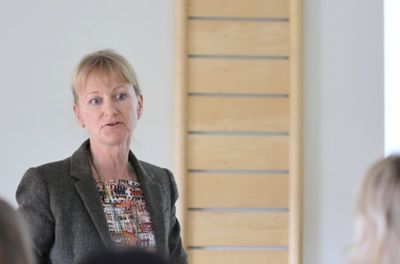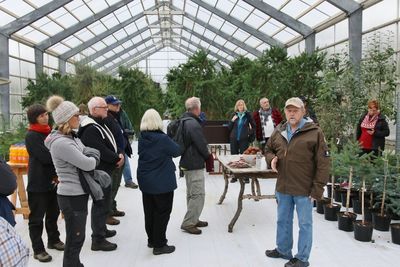Countless trees from a single seed
10.11.2017

Miklir möguleikar felast í því að fjölfalda skógarplöntur úr einni og sömu okfrumunni, ekki síst í jólatrjáarækt enda gefur þessi aðferð færi á að rækta milljónir plantna sem verða meira og minna nákvæmlega eins. Nú virðist hilla undir að hægt verði að senda fræ af úrvalstrjám til fjölföldunar á rannsóknarstofu. Tímafrekt er að vinna slíkt í höndunum og því hafa verið þróaðir róbótar sem ættu að geta gert þessa vinnu fljótlegri og hagkvæmari. Skjámynd úr myndbandi: Ulrika Egertsdotter/UPSC/SLU.
Automation of clonal production of conifers improving fast
Cost-effective methods for providing vast numbers of identical Christmas trees from a single seed seem to be in sight. Automated technology for plant tissue culture-based (somatic embryogenesis) production of conifer trees is in great progress giving hope for the provision of a variety of seedlings with desirable properties. This was among the subjects discussed recently at the 13th Christmas Tree Research and Extension Conference, CTRE2017, held in Akureyri North-Iceland 4-8 September. The conference was hosted by the Icelandic Forest Research Mógilsá, research division of the Icelandic Forest Service (GO).
The main topics of the conference were cultivation and breeding conditions, Christmas tree breeding, pests and diseases as well as treatment of Christmas trees all the way from harvest to customer delivery. Being a huge concern for Christmas tree growers pests and diseases were rather prominent in the discussions as various plagues are gaining new ground in warming climate.
Two talks on somatic embryogenesis (SE) drew much attention at the conference. SE is a plant tissue culture technique used to make genetically identical copies of plants from a single seed. Multiplying forest plants from one and the same seed has many advantages for the Christmas tree industry, especially since the SE technology allows for production of millions of identical plants.
Robert Thomas, research scientist at the University of North Carolina USA, discussed SE in Fraser fir (Abies fraseri) and experiments on optimising levels of abscisic acid, polyethylene glycol and maltose for maturation. Certain substances control the development of the embryo tissue, but the proportion of these substances varies according to species. Fraser fir is widely used as a Christmas tree in North Carolina. Robert pointed out a variety of benefits for the Christmas tree industry if an affordable method of mass production was available. The production of seedlings would be much faster, clonal trees produced more homogenous, genetic modifications enabled allowing for future engineering of disease resistance, increased production and better traits etc.
 In other words, it now seems we are at the dawn of a new era in Christmas tree production. Soon we could be sending seeds from a selection of samples for mass propagation at a laboratory with state of the art automation technology. Plant tissue culture is a time consuming and labour-intensive task. There has therefore been a big need for improvements in automation technology to make this work faster and more cost-effective. Ulrika Egertsdotter is a professor at the Swedish Agricultural University, SLU, Umeå Sweden, and principal scientist at the Georgia Tech in Atlanta Georgia USA. In her lecture at the CTRE conference she presented the automated technology for SE plant production developed at Georgia Tech and supported by Swedish forestry industry, generating the hope that SE will soon become a viable method also for the Christmas tree industry.
In other words, it now seems we are at the dawn of a new era in Christmas tree production. Soon we could be sending seeds from a selection of samples for mass propagation at a laboratory with state of the art automation technology. Plant tissue culture is a time consuming and labour-intensive task. There has therefore been a big need for improvements in automation technology to make this work faster and more cost-effective. Ulrika Egertsdotter is a professor at the Swedish Agricultural University, SLU, Umeå Sweden, and principal scientist at the Georgia Tech in Atlanta Georgia USA. In her lecture at the CTRE conference she presented the automated technology for SE plant production developed at Georgia Tech and supported by Swedish forestry industry, generating the hope that SE will soon become a viable method also for the Christmas tree industry.
The standard SE method depends on manual handling between different culture conditions for progression through sequential developmental steps, where the harvesting of mature embryos is the most time-consuming step. Furthermore, culturing in petri plates and other plastic consumables are both inefficient and costly. Fluidics-based technologies for automating the SE method have significant potential in clearing these hurdles.
With the recent invention of an automated ‘SE fluidics system' for multiplication, maturation, harvest, germination and planting, large scale production of conifer SE plants can be realized. Automated fluidics-based handling of the embryos for harvest, imaging and sorting provides new opportunities for creating a large database correlating the morphology and physical characteristics of embryos to the quality traits of plant formation resulting in high quality plants.
 Novel design of temporary immersion bioreactors allows for improved development in several steps of the SE process, and reduced handling time. The fluidics based technology has already been successfully demonstrated for the full line of production of Norway spruce plants, from bioreactor to nursery and field planting. Based on Ulrika and her colleagues' previous results from SE in firs and recent results demonstrating superior growth and development of fir SE cultures in bioreactors over petri plates, the fluidics system should be well suited for scale up production of SE plants also in firs.
Novel design of temporary immersion bioreactors allows for improved development in several steps of the SE process, and reduced handling time. The fluidics based technology has already been successfully demonstrated for the full line of production of Norway spruce plants, from bioreactor to nursery and field planting. Based on Ulrika and her colleagues' previous results from SE in firs and recent results demonstrating superior growth and development of fir SE cultures in bioreactors over petri plates, the fluidics system should be well suited for scale up production of SE plants also in firs.
According to Ulrika the results indicate that the method should also be suitable to speed up the mass production of firs. This makes hopes for the small but growing Icelandic Christmas tree industry as breeding of subalpine fir for Christmas tree production has been going on in the country for a while. The improved material is already there and the first seeds from newly planted seed orchards are expected in a few years.
The following video gives some insight into the automated ‘SE fluidics system' technology that has been developed to produce large numbers of conifer tree seedlings.
